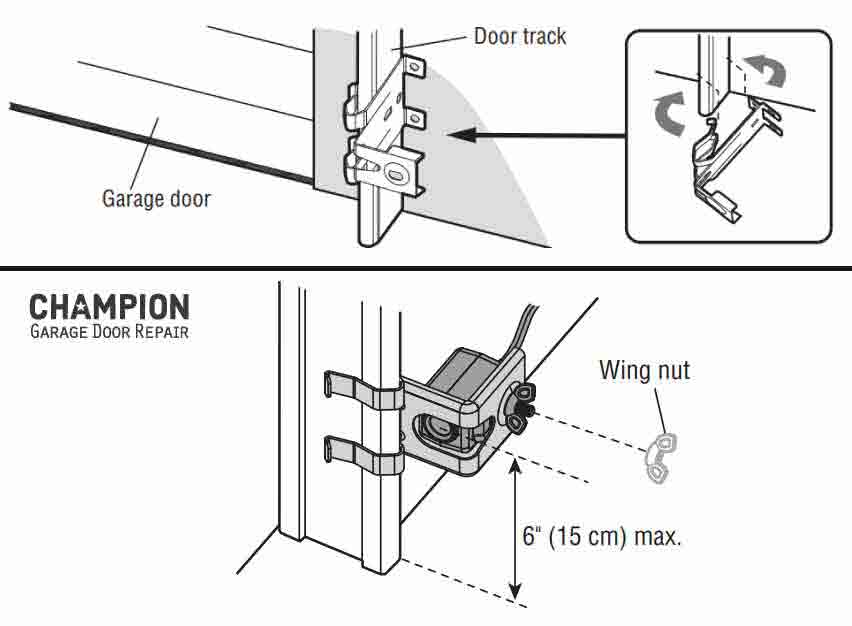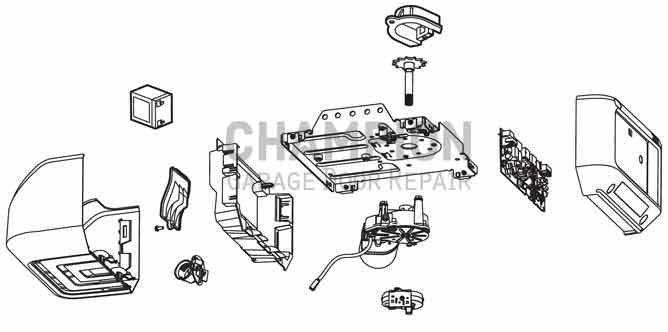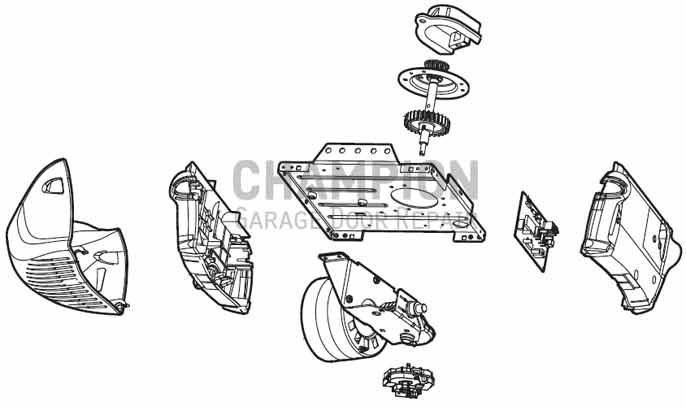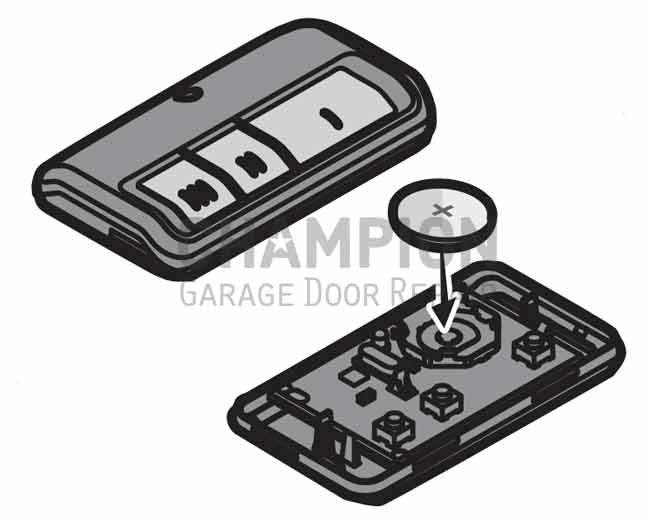Read below to learn how to repair malfunctioning garage door openers of all makes and models, addressing common problems and specific symptoms.
1. Safety Sensors
Safety sensors, also known as photo eyes, utilize a beam of light to detect objects or people in the door’s path. When the beam is interrupted, they activate safety measures to prevent accidents.
Symptoms of Malfunctioning Photo Eyes:
- Garage door won’t close.
- Garage door goes down 6 inches then back up.
- Garage door keeps popping back up.
- Garage door closes, then opens, and light blinks.
- Garage door won’t close all the way.
- Garage door only closes when holding the button.
- Opener’s error codes 11, 12, 46, or troubleshooting LED flashing red.
- The sensor’s LED is constantly flashing or off.
How to Fix It:
- Remove any items that may obstruct the sensors.
- Clean the sensors’ lenses with a dry washcloth.
- Realign both sensors until both LEDs are glowing steadily.
- Inspect the wire and repair any kinks or breaks.
- Replace the photo eyes.

2. Travel Module or Limit Switch
Travel modules or limit switches are components commonly used in garage door openers to set the limits for the door’s movement. In older opener models, these switches may have been positioned along the opener’s rail. However, newer openers utilize a module inside the motor, which is activated when the door reaches a predetermined position.
Symptoms of Malfunctioning Travel Module or Limit Switch:
- Travel limits cannot be set.
- Garage door hits the floor then goes back up.
- Garage door moves a few inches, then stops or reverses.
- Garage door starts to close then goes back up.
- Opener’s error codes 32, 45, 15, or troubleshooting LED is steady red.
How to Fix It:
- Re-program limits.
- Ensure that all wires and harnesses are connected properly.
- Replace the opener’s travel module or limit switch.

3. Trolley or Carriage
Trolleys are used in ceiling mount garage door openers and involve the use of a carriage that can move along the opener’s rail assembly. Worn trolleys are more common in screw drive garage door openers compared to chain or belt openers.
Symptoms of Worn or Broken Trolley:
- Garage door makes a loud grinding noise.
- Garage door cannot be engaged or reengaged to the opener.
- Garage door opener runs but the door won’t move.
How to Fix It:
- Inspect the trolley for wear or breakage.
- Replace the trolley or carriage if needed.
4. Gear and Sprocket Assembly
Garage door gear and sprocket assemblies use interlocking toothed wheels to transmit motion and power between the motor’s rotating shafts and the opener’s rail assembly. In older opener models, the gear and sprocket assembly used to be separate components. However, in newer opener models, including DC openers, they are integrated into the motor assembly itself, which makes it more complicated to troubleshoot and repair.
Symptoms of Worn Gear and Sprocket Assembly:
- Opener’s travel limits cannot be set.
- Garage door opener loses its limit settings.
- Garage door opener makes grinding or clicking noises.
- Garage door opener runs but the door won’t move.
How to Fix It:
- Inspect the opener’s gear and sprocket for wear or breakage.
- Replace the gear and sprocket assembly if necessary.
- Replace the motor assembly in newer opener models.

5. Motherboard
The garage door opener’s motherboard is the main circuit board that serves as the central hub for connecting and controlling various components. This motherboard acts as the primary interface for coordinating the operation of the travel module, photo eyes, switches, and other electronic components.
Symptoms of Malfunctioning Motherboard:
- Garage door won’t move, opener makes a clicking sound.
- No power coming to the opener.
- The battery backup status LED is flashing green.
How to Fix It:
- Unplug the opener from the outlet and plug it back in.
- Ensure that all wires and harnesses are connected properly.
- Replace the opener’s motherboard if needed.
6. Receiver and Remote Controls
The receiver and remote controls facilitate wireless operation and control of overhead garage doors. The receiver, installed within the opener unit, picks up signals from remote controls or keypads, allowing users to remotely start, stop, and perform other functions without direct contact.
Symptoms of Malfunctioning Receiver or Remote Control:
- Remote controls and keypads won’t open or close the door.
- Remote control LED won’t turn on when pressing the remote’s button.
- Receiver LED won’t turn on when pressing the learn button.
How to Fix It:
- Re-program remote controls to the opener.
- Replace the remote control’s battery or the remote control.
- Replace the opener’s receiver if needed.

7. Frequency Interference
Frequency interference is a disruption caused by overlapping radio frequency (RF) signals that interfere with the proper functioning of the garage door opener. This interference can lead to communication loss between the opener and its remote controls.
Symptoms of Frequency Interference:
- Garage door opener remote and keypad only work sometimes or not at all.
- Garage door works only during specific hours.
- Garage door opener suddenly loses range.
- Garage door only works up close or from a close range.
- Garage door not opening or closing with the remote, keypad, and car.
- Garage door not working from outside the garage.
- Garage door only opening but not closing with the remote, keypad, and car, or vice versa.
How to Fix It:
- Locate and eliminate the interference source.
- Update the opener’s frequency to 310, 315, and 390 MHz Tri-Band.
- Use the opener’s Wi-Fi to operate the garage door.
8. Belt
Garage door belt assemblies use flexible belts made of materials like rubber or synthetic fibers to transfer motion between the opener’s sprocket and the trolley assembly.
Symptoms of Worn or Loose Belts:
- Garage door opener runs but the door won’t move.
- Garage door opener loses its limit settings.
- Rubber pieces from the belt are coming off.
- Garage door opener judders.
- Garage door opener makes a grinding sound.
How to Fix It:
- Inspect the opener’s belt for wear or slack.
- Adjust the belt tension if its loose.
- Replace the opener’s belt if needed.
- If the belt is not available, replace the rail assembly or the entire opener unit.
Follow proper opener repair procedures as directed by the manufacturer to avoid further damage, ensure safety, and prevent injuries. Consult a licensed garage door repair company if needed, and to find out if your opener is still under warranty.








